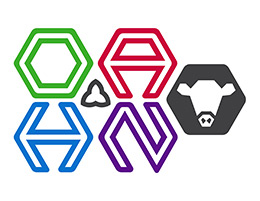Ontario Animal Health Network (OAHN) Bovine Expert Network Quarterly Veterinary Report
Webinar: Trace Mineral Monitoring in Beef Cattle Herds
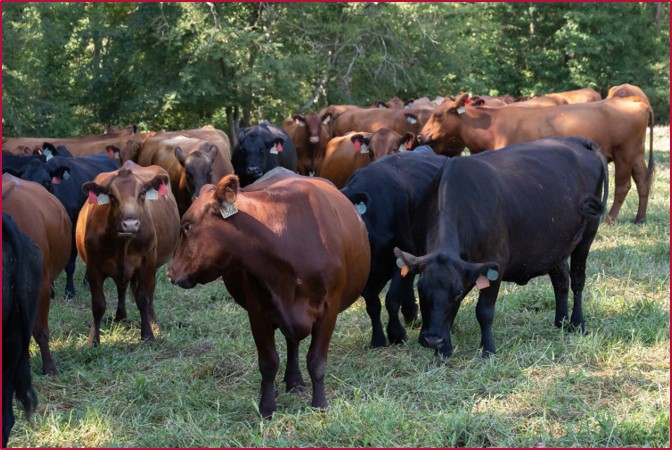 Wednesday May 10
Wednesday May 10
7:00-8:30 PM EST
As part of the OAHN bovine trace mineral project, Ontario bovine veterinarians submitted blood samples from beef cows to determine trace mineral status and assess risk for trace mineral disorders.
Join us virtually to hear project results and from trace mineral expert Dr. Cheryl Waldner on optimizing outcomes in cow-calf herds through more effective management of micronutrient supplementation programs.
Register in advance for this meeting:
https://zoom.us/meeting/register/tJIpf-2qpzssHdfNHjKOEud-KtJD69ws7sTK
OAHN-OABP In Clinic Milk Culture Survey
The OAHN bovine network and OABP are jointly conducting a short survey on in-clinic milk culture to better understand the current practices and needs of bovine vet clinics. The survey is for both clinics offering in-clinic culture and not offering in-clinic culture currently; one survey per clinic.
All information shared will remain confidential and only a summary of results will be shared. The survey can be accessed at https://uoguelph.eu.qualtrics.com/jfe/form/SV_3vBVIh2QQQ86bu6
Salmonella Dublin Update
Laboratory Data
During 2022, 25 lab diagnostic submissions to the AHL detected Salmonella Dublin (Figure 1) plus an additional 23 research submissions. The submissions are estimated to represent 23 separate outbreaks from 21 different farms. For 13 farms, this was their first diagnosis of S. Dublin (Figure 2). This compares to 24 outbreaks and 14 first premises diagnoses in 2021.
As of December 31, 2022, there are estimated to be 91 unique premises in the laboratory dataset that have had S. Dublin, of which 36 are veal, 51 are dairy, and 4 are from a beef operation. Notably, this year 2 premises identified as beef had outbreaks of S. Dublin raising dairy X beef calves.
Bulk Tank Surveillance Project
In the fall 2022, the Bulk Tank Surveillance project released individual results to all dairy producers for a panel of bulk tank testing. Details of the tests used, and their interpretation are available at https://dairyatguelph.ca/factsheets/. A second round of testing, including S. Dublin will be completed in spring 2023 (see page 7).
For more information on the project, listen to the bovine OAHN podcast with Dr. David Kelton at https://oahn.podbean.com/category/bovine/.
Salmonella Dublin Testing in Milk
The AHL has verified the PrioCheck Salmonella Dublin antibody ELISA for milk samples and is now accepting both milk (individual animal milk samples and bulk tank milk samples) and serum (individual serum samples) for Salmonella Dublin antibody ELISA testing.
For more details on the test validation and recommendations for sample collection, check out the AHL Newsletter 2023;27(1):14 at https://www.uoguelph.ca/ahl/salmonella-dublin-testing-milk-now-available.
Ontario Interactive Animal Pathogen Dashboards (IAPD)
The IAPDs were developed to monitor and report current and historical trends in pathogens of special interest to the Ontario food animal industry.
Bovine pathogens of interest include Salmonella Dublin Individual and Bulk, Bovine viral diarrhea virus, and Mycoplasma bovis.
For access to the dashboards, visit https://iapd.lsd.uoguelph.ca/. All Ontario veterinary clinics are eligible for a unique login.
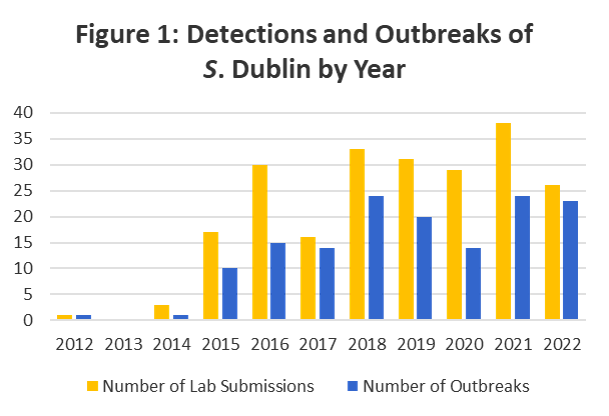
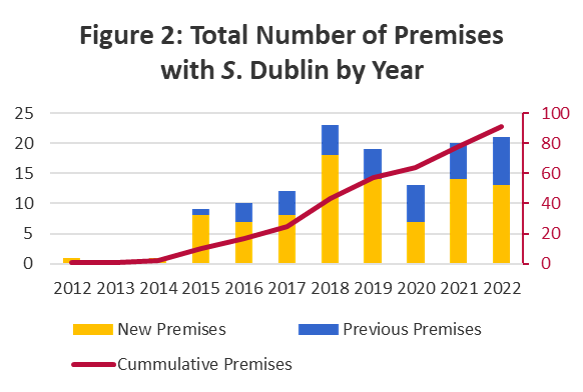
Mastitis PCR Test Data for Ontario Lactanet Herds
2021 and 2022
Summary provided by Dr. David Kelton, OVC in collaboration with Lactanet
| 2021 Ontario Mastitis PCR Summary | Number of Samples | Percent of Samples | Group Avg SCC (x1000) |
| Staph aureus POS | 1303 | 15.10% | 1178 |
| S aureus HIGH POS | 84 | 6.44% | 3619 |
| S aureus MOD POS | 567 | 43.51% | 1349 |
| S aureus LOW POS | 652 | 50.04% | 714 |
| Strep ag POS | 3 | 0.03% | 294 |
| Mycoplasma POS | 10 | 0.12% | 2376 |
| Prototheca POS | 194 | 2.25% | 1203 |
| NEG to all 4 pathogens | 7151 | 82.77% | 1120 |
| Total | 8640 | 1131 |
| 2022 Ontario Mastitis PCR Summary | Number of Samples | Percent of Samples | Group Avg SCC (x1000) |
| Staph aureus POS | 1111 | 15.30% | 1220 |
| S aureus HIGH POS | 110 | 9.90% | 3373 |
| S aureus MOD POS | 454 | 40.86% | 1349 |
| S aureus LOW POS | 547 | 49.23% | 639 |
| Strep ag POS | 0 | 0.00% | NA |
| Mycoplasma POS | 8 | 0.11% | 5180 |
| Prototheca POS | 131 | 1.80% | 1199 |
| NEG to all 4 pathogens | 6011 | 82.99% | 1011 |
| Total | 7243 | 1050 |
Interpretation Notes
- While 15% of samples were positive for Staph aureus, less than 10% were HIGH positive
- For Staph aureus cows, SCC is correlated with PCR result, as expected
- Caution: Low positive Staph aureus tests might not be infected – check SCC
- Only 4 of 15,883 samples positive for Strep ag (eradicated!)
Mastitis Pathogens from Milk Cultures Submitted to the Animal Health Laboratory in 2021 and 2022
Summary provided by Dr. Tanya Rossi and Dr. Durda Slavic
In 2021, there were 4,649 individual milk samples sent to the AHL.
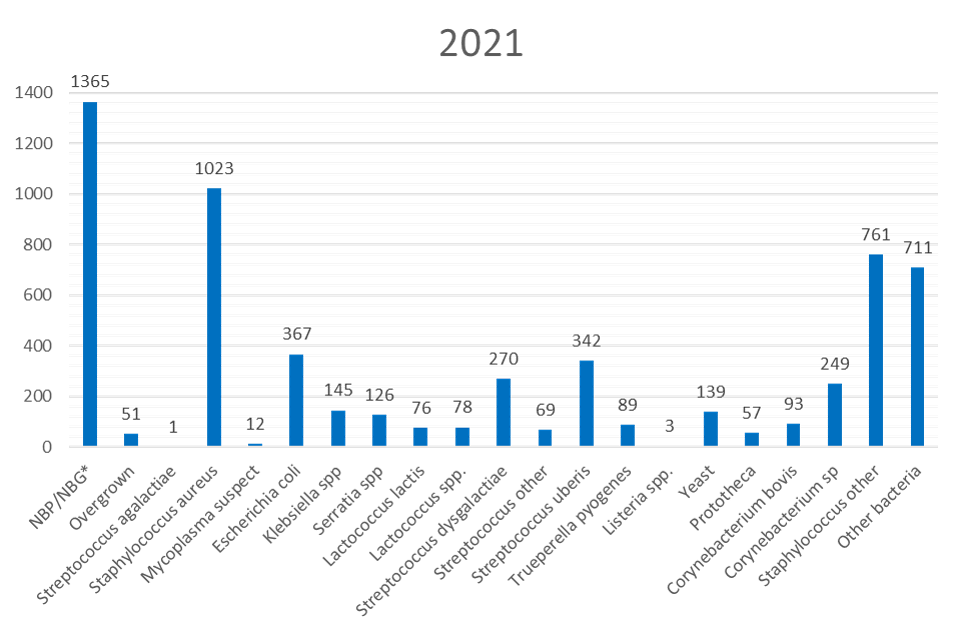
In 2022, there were 3,381 individual milk samples sent to the AHL.
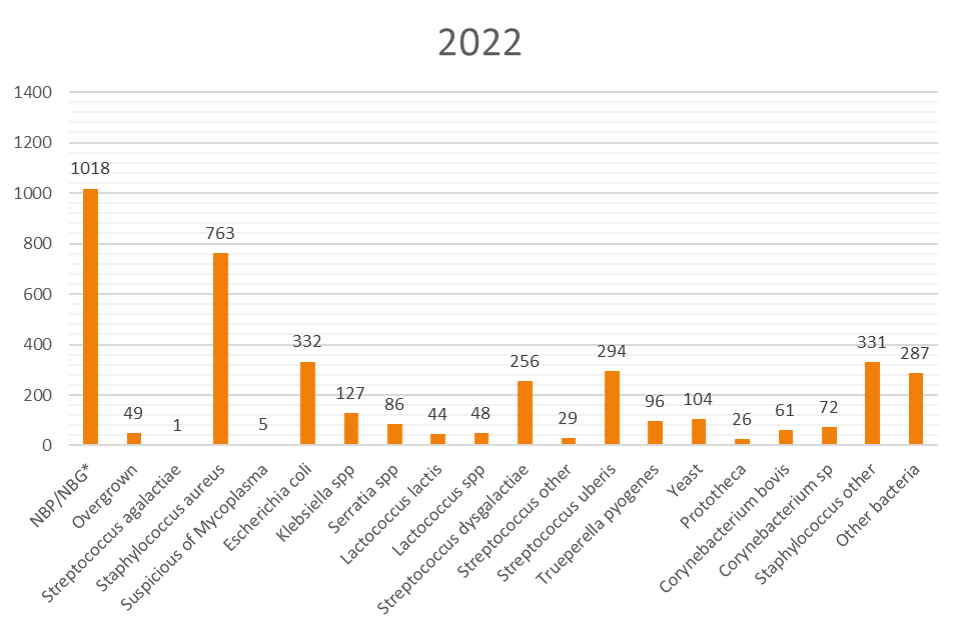
OAHN Q3 and Q4 Bovine Animal Health Laboratory Data
During Q3 (August 1 to October 31, 2022) and Q4 (November 1, 2023 to January 31, 2023), there were 172 and 197 bovine pathology submissions to the AHL, respectively.
CASE HIGHLIGHTS
- Necropsy identified septicemia and embolic hepatitis caused by Salmonella Dublin in a 3-year-old beef cow. She had a calf at foot and was brought in from pasture in early August when she was found to be dull and lethargic and was subsequently euthanized when non-responsive to treatment.
- Three related submissions of slaughter samples from white veal over the course of several months identified eosinophilic myositis, with presence of Sarcocystis-type organisms in myocytes identified microscopically in one case. Bovine eosinophilic myositis is hypothesized to result from degradation of encysted Sarcocystis spp organisms in muscle, inciting an inflammatory and possibly hypersensitivity–type response. In addition, microscopic examination of liver in two of the three cases, revealed eosinophilic portal hepatitis with lesions typical of larval parasite migration, most likely caused by liver flukes.
- Two unrelated cases of late term abortion (approx. 7 months gestation) and stillbirth in beef cattle during the month of December, where necropsy identified congenital myopathy resulting in fetal heart failure. Both had microscopic lesions of myocardial necrosis and mineralization, and PCR testing did not detect BVDV in either case. In the stillbirth, testing of fetal liver did not implicate micronutrient deficiency or toxicity. In the abortion, fetal hepatic selenium levels were marginal, suggesting that selenium deficiency was a contributing factor in this case (concurrent vitamin E deficiency may have been present, but testing was not performed in this case).
- A 1-day-old Holstein calf was born with a multicystic structure protruding from the vagina (see photo courtesy of Dr. Niki Alsop), and microscopic examination revealed a vaginal fibrovascular and multicystic mass with presence of cartilage amid the fibrous stroma. Few reports of similar anomalous congenital structures were identified in the veterinary literature, being termed vaginal hamartoma or vestibular “wattle”.
- In some instances, a diagnosis could not be attained for pathology submissions, often due to limited sampling for histology and/or lack of fresh tissue for ancillary testing. The AHL website has several bovine diagnostic plans available to help guide diagnostic investigations, including diarrhea, respiratory disease, neurologic disease, abortion, and sudden death (https://www.uoguelph.ca/ahl/diagnostic-plans/diagnostic-plans-bovine)
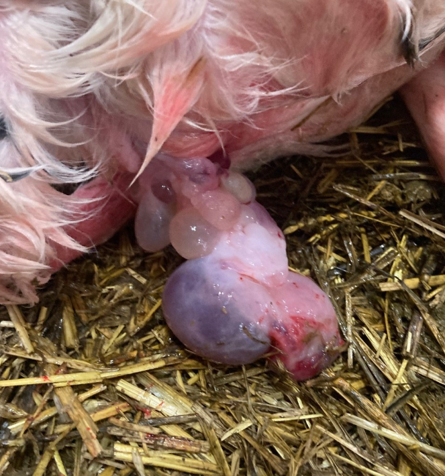
SALMONELLA
Q3: In total, 216 bovine submissions had bacterial culture performed (non-milk), generating 361 cultures. Salmonella spp. were isolated from 27 submissions, representing an estimated 16 premises.
- Salmonella Dublin was isolated from 20 submissions, representing approximately 9 premises. Primary findings associated with isolation of S. Dublin (if provided), included pneumonia, arthritis, meningitis, anorexia, diarrhea and sudden death.
- Late term abortion in a dairy cow caused by Salmonella Motevideo
- Watery diarrhea, off feed, and pyrexia in mature dairy cattle, with approximately 10 cows affected over 2 months (non-pathology submission). Fecal culture isolated Salmonella Typhimurium from enriched culture, and PCR testing was negative for BVDV and coronavirus.
Q4: In total, 230 bovine submissions had bacterial culture performed (non-milk), generating 336 cultures. Salmonella spp. were isolated from 32 submissions, representing an estimated 10 premises.
- Salmonella Dublin was isolated from 30 submissions, representing approximately 7 premises. Primary findings associated with isolation of S. Dublin (if provided), included poor doing, pneumonia, arthritis, diarrhea and death.
- Salmonella Cerro was isolated from enriched culture for two unrelated (non-pathology) submissions, which had detection of other enteric pathogens:
1.Holstein calves under 1 month of age and as early as 3 to 4 days of age presenting with pyrexia and watery diarrhea with mucus. The enteric panel was performed on feces from two calves, and rotavirus A was detected in both samples, with Salmonella Cerro isolated from enrichment in only one of the two samples.
2.Three-day-old Holstein calf that nursed once and then stopped, became dehydrated and died with evidence of bloody diarrhea. Fecal culture isolated F5/K99+ E. coli (ETEC), along with Salmonella Cerro from enrichment.
BOVINE VIRAL DIARRHEA VIRUS (BVDV)
Q3: A total of 142 BVDV PCR tests were performed, with 3 positive results generated from 3 separate submissions.
- 6-month-old beef calf with chronic bronchopneumonia, poor body condition (suspected PI)
- 8-week-old dairy calf: Chronic poor-doer in a BVDV positive herd
- Herd screening
Q4: A total of 160 BVDV PCR tests were performed, with 1 positive result.
- Herd screening
| About This Report |
| This summary has been compiled by Dr. Rebecca Egan, Animal Health Laboratory (AHL) from diagnostic submissions to the AHL Guelph and Kemptville locations. |
Articles of Interest:
- Second Round Leukosis Testing: Herd health surveillance project continues in 2023 https://farmersforum.com/second-round-leukosis-testing-begins/
- Development of a predictive model for bovine leukemia virus proviral load https://www.ncbi.nlm.nih.gov/pmc/articles/PMC9511096/
Help us help you!
Have an idea for an infographic you’d like to see, or a podcast you’d like to hear? Email oahn@uoguelph.ca to let us know!
